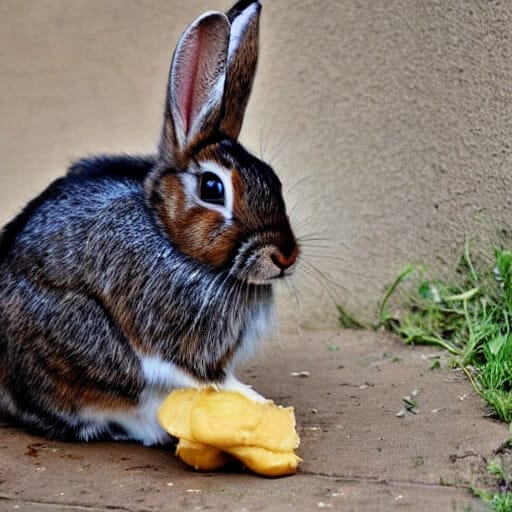Rabbits make a sound called a thump or thumping sound. Rabbits communicate through various sounds, and one of the sounds they make is a thump or thumping sound.
This sound is produced when a rabbit forcefully stomps their hind legs on the ground. While thumping, rabbits emit a loud noise that can be heard by other rabbits and predators in their vicinity. This sound serves as a warning signal to alert others of potential danger or to communicate their discomfort.
Thumping can also be a sign of frustration or territorial behavior. Understanding the sounds rabbits make can help rabbit owners better comprehend their pets’ needs and emotions. In addition to thumping, rabbits may also produce other vocalizations such as chirping, growling, or whimpering sounds.
The Intriguing Whispering World Of Rabbits
Rabbits are fascinating creatures known for their adorable appearance and gentle nature. While they may not be as vocal as some other animals, they do communicate in their own unique way. Unlike cats and dogs, rabbits don’t bark or meow, but they still make sounds that convey meaning.
Rabbit vocalizations can vary, and each sound has its own significance. One of the most common sounds is the purring, which indicates contentment and relaxation. It’s similar to the sound a cat makes when it’s happy. On the other hand, rabbits may also emit a gentle humming or buzzing sound, which usually signifies annoyance or displeasure. It’s like their way of saying “back off” or “leave me alone.”
Understanding the significance of rabbit vocalizations is essential for any rabbit owner. These sounds provide valuable insights into their emotional state and can help us determine if they’re happy, stressed, or in need of attention. By paying attention to these subtle vocal cues, we can create a harmonious and nurturing environment for our furry friends.
The Spectrum Of Rabbit Sounds
Chirps and coos are some of the soft and gentle sounds that rabbits make. These delicate vocalizations express their calmness and happiness. Sometimes, they can be heard while rabbits are feeding or being gently stroked. On the other hand, growls and grunts signify a more aggressive communication style. When rabbits feel threatened or territorial, they emit these sounds to warn others. Squeaks and screams are distress calls that rabbits use when they are in pain or extreme fear. These high-pitched noises are unmistakable and indicate a need for immediate attention. Lastly, purring and humming sounds are associated with contentment and comfort. Rabbits produce these gentle vibrations when they feel relaxed and safe.
| Sound Type |
Description |
| Chirps and coos |
Soft and gentle sounds expressing calmness and happiness |
| Growls and grunts |
Aggressive vocalizations indicating threat or territorial behavior |
| Squeaks and screams |
High-pitched distress calls when in pain or fear |
| Purring and humming |
Contentment and comfort sounds indicating relaxation |
Interpreting Rabbit Vocalizations
Interpreting rabbit vocalizations is crucial for understanding a rabbit’s emotions and needs. Rabbits use various sounds as a means of communication, expressing their desires and establishing social connections. Rabbits can make a range of vocalizations, each with its own emotional context. For instance, a loud growl or grunt often indicates displeasure or aggression, while a soft purring sound signifies contentment. When rabbits feel threatened or scared, they may emit a high-pitched scream or squeal. On the other hand, gentle clucking or cooing sounds indicate a rabbit’s affection or happiness.
Rabbits also utilize sounds to express their needs. When they are hungry, they may emit a low rumbling sound, which can increase in volume and intensity if their hunger persists. A rabbit may also communicate its desire for attention or playfulness through rhythmic tooth purring or honking sounds. Understanding these vocalizations is essential for providing appropriate care and addressing their needs adequately.
Rabbit Sound Variations Across Breeds
Discover the wide range of sounds that rabbits produce, with variations across different breeds. From soft purring to gentle thumping, rabbits communicate in their own unique way. Explore what sound a rabbit makes and understand the diverse language of these adorable creatures.
|
|
Recognizing breed-specific variations in vocalizations
|
| Rabbits communicate through various vocalizations, and these sounds can differ depending on the breed. Recognizing the breed-specific variations in their vocalizations can give valuable insights into their behaviors and needs.
Analyzing the impact of genetics on rabbit sounds is crucial in understanding these variations. Different breeds have been selectively bred over time, resulting in distinctive characteristics, including the sounds they produce.
For example, lionhead rabbits are known for producing soft humming or purring sounds when they are content, while Dutch rabbits tend to make low, repetitive grunting sounds when they are stressed or annoyed.
By paying close attention to the sounds your rabbit makes, you can gain a deeper understanding of their emotions and overall well-being. This knowledge can help you provide the appropriate care and address any specific needs they may have. |
Bunny Talk: Tips For Understanding Your Rabbit
Understanding the sounds that rabbits make can help you develop a deeper bond with your pet. Rabbits have a unique way of communicating through various sounds and behaviors. By paying attention to these cues, you can better understand what your rabbit is trying to communicate. Some common behavioral cues accompanying specific sounds include:
- Happy and content: Rabbits express their happiness through purring and soft teeth grinding.
- Annoyed or scared: A rabbit might growl or hiss to indicate fear or anger.
- Panic or pain: If your rabbit makes loud, high-pitched noises or thumping sounds with its hind legs, it might be in distress.
- Demanding attention: Rabbits can be quite vocal when they want attention, often making gentle honking sounds.
- Exploration and curiosity: Soft sniffing and purring noises are common when rabbits are exploring their surroundings.
- Mating or territorial behavior: Male rabbits may grunt, growl, or make a throaty noise to establish dominance or attract a mate.
By listening and observing your rabbit’s sounds and accompanying behaviors, you can better understand their needs, emotions, and establish a stronger bond with your furry friend.
Rabbit Sound Experiments And Studies
Underground research: Examining the vocalizations of wild rabbits
Studying the vocalizations of wild rabbits has revealed fascinating insights into their communication patterns. Researchers have conducted underground research to understand the sounds that rabbits make. This research has shed light on the various vocalizations they use to communicate with their counterparts. Wild rabbits emit a range of sounds, including low growls, high-pitched whistles, and rhythmic purring. These sounds serve different purposes, such as warning other rabbits of potential danger or asserting dominance within their social hierarchies. By observing and recording these vocalizations, scientists are able to analyze the complex communication systems of wild rabbits.
Captive rabbit studies: Insights into domesticated rabbit sounds
Domesticated rabbits, on the other hand, have been the subject of numerous studies to understand their unique vocalizations. Through captive rabbit studies, researchers have discovered that domestic rabbits have a wider range of vocalizations compared to their wild counterparts. These vocalizations include honking, chirping, and even some soft cooing sounds. It has been found that domestic rabbits use vocalizations not only for communication but also to express emotions such as excitement, fear, and contentment. By recognizing and interpreting these sounds, rabbit owners can better understand the needs and emotions of their furry companions.
Ensuring A Healthy Soundscape For Rabbits
Ensuring a healthy soundscape for rabbits is essential for their well-being. Excessive noise can have negative effects on rabbits, causing stress, anxiety, and even health issues. To create a peaceful environment, consider soundproofing the rabbit enclosures.
Here are some soundproofing tips for rabbit enclosures:
- Insulate the walls: Use soundproofing materials such as acoustic foam or mass-loaded vinyl to absorb and block out noise.
- Sealing gaps: Check for any gaps or cracks in the enclosure and seal them with weatherstripping or silicone caulk to prevent sound leakage.
- Soft flooring: Use carpets, rugs, or rubber mats on the floor of the enclosure to absorb sound vibrations.
- Minimize equipment noise: Place any noisy equipment such as fans or pumps outside the enclosure or choose quiet alternatives.
Remember that maintaining a quiet environment is important for rabbits’ overall well-being. By implementing these soundproofing techniques, you can help create a peaceful and stress-free space for your furry friends.
Frequently Asked Questions On What Sound Does A Rabbit Make
What Sound Does A Rabbit Make?
Rabbits make a variety of sounds to communicate. They can purr when they are content, growl if they are angry or threatened, and make a high-pitched squeal when they are in pain. However, rabbits are generally quiet animals and may not make much noise unless they are feeling frightened or stressed.
Conclusion
To sum things up, rabbits communicate through a variety of sounds that reflect their emotions and behaviors. From gentle purring and grunting to loud growls and shrieks, these furry creatures use their voice to express joy, fear, and warning signals.
Understanding the vocal language of rabbits is essential for their well-being and our ability to bond with them. So, the next time you hear your rabbit making sounds, pay attention and try to decipher their message. Happy rabbit caring!


